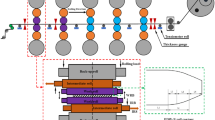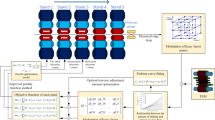Abstract
Controlling the profile and edge drop in the cold rolling process is crucial especially in applications involving silicon steel. In non-oriented silicon steel production, the work rolls shifting control is widely applied in 6-high tandem cold mills and the differences of the control characters of different stands have been gradually recognized. However, because of the lack of research on shifting control effect of separate stands and their influence between each other, controlling the edge drop by cooperatively shifting the work rolls of multiple stands is still impossible, so the mills’ capability is not utilized efficiently. In this study, we develop a finite element method (FEM) model to investigate this issue. Based on the results of the FEM model, we conclude that work roll shifting of different stands leads to the independent control of edge drop, obtain the shifting control effect of different stands to their exit, and the attenuation effects by the following stands. Besides, we deduce that the approach to calculating the edge drop control characteristics should be modified to summation equation of the attenuation effects. The results of an experiment involving 6-high tandem cold mills are in agreement with the results of calculation with the FEM model and we demonstrate the high precision of the FEM model and the reliability of the subsequent analysis. Based on the edge drop control characters established, the control model and the cooperation strategy were designed and applied to the practical production, and significant improvements of edge drop and transverse thickness deviation were obtained.














Similar content being viewed by others
References
Mancini E, Campana F, Sasso M, Newaz G (2012) Effects of cold rolling process variables on final surface quality of stainless steel thin strip. Int J Adv Manuf Technol 61(1):63–72. https://doi.org/10.1007/s00170-011-3698-3
Tateno J, Kenmochi K, Yarita I, Kaneko T, Yamada Y (1999) Controlling edge drop by tapered-crown work roll shifting mill and work roll crossing mill in cold strip rolling. J Jpn Soc Technol Plast 40:653–657
Aizawa A, Hara K, Nakamoto K, Otsuka M, Hayakawa J, Miki T (1998) Development of technology for controlling edge-drop in cold tandem mill. Proceedings of the 7th International Conference on Steel Rolling, Chiba, Japan, pp 766-771
Omori S, Kajiwara T (2004) Analysis of rolling load generated by pair crossed rolling mill. Ironmak Steelmak 31:71–80. https://doi.org/10.1179/030192304225012088
Hartung HG, Hollmann FW (1998) EDC—a new system for reduction of edge drop in cold rolling. MPT Metall Plant Technol Int 22:80–82
Li YL, Cao JG, Kong N, Wen D, Ma HH, Zhou YS (2017) The effects of lubrication on profile and flatness control during ASR hot strip rolling. Int J Adv Manuf Technol 91:2725–2732. https://doi.org/10.1007/s00170-016-9910-8
Song GY, Wang XC, Yang Q (2018) Study on mathematical model of work roll wear in skin-pass rolling of hot steel strip. Int J Adv Manuf Technol 97(5–8):2675–2686. https://doi.org/10.1007/s00170-018-2076-9
He AR, Zhang QD, Yang Q (2004) Optimum configuration of modern tandem cold rolling mill. Ironmak Steelmak 39:43–46
Xu L J (2007) Flatness control in cold strip rolling and mill type selection. Metallurgical Industry Press, Beijing, pp 45
Takami KM, Mahmoudi J, Dahlquist E, Lindenmo M (2011) Multivariable data analysis of a cold rolling control system to minimise defects. Int J Adv Manuf Technol 54(5):553–565. https://doi.org/10.1007/s00170-010-2946-2
Kitamura K, Nakanishi T, Yarita I (1995) Edge-drop control of hot and cold rolled strip by tapered-crown work roll shifting mill. Iron Steel Eng 72(20):27–32
Du X Z (2009) Research on mechanics of edge drop and its control technology in cold strip mill for high precision silicon steel. University of Science and Technology Beijing, Beijing, China
Chen X L, Zou J X (1987) A special finite element model for investigating controlling factors affecting behavior of rolls and strip flatness. Proc of the 4th International Steel Rolling Conf, Deauville, France, 2: E4.1-E4.7
Jiang ZY, Xiong SW, Tieu AK, Jane Wang Q (2008) Modeling of the effect of friction on cold strip rolling. J Mater Process Technol 201:85–90. https://doi.org/10.1016/j.jmatprotec.2007.11.128
Wang XC, Yang Q, Jiang ZY, Xu JW (2014) Research on the improvement effect of high tension on flatness deviation in cold strip rolling. Steel Res Int 85:1560–1570. https://doi.org/10.1002/srin.201400048
Chen BK, Choi SK, Thomson PF (1989) Analysis of plane strain rolling by the dynamic relaxation method. Int J Mech Sci 31(11):839–851. https://doi.org/10.1016/0020-7403(89)90028-3
Lindgren LE, Edberg J (1990) Explicit versus implicit finite element formulation in simulation of rolling. J Mater Process Technol 24:85–94
Liu LZ, Liu X, Jiang ZY (2001) Strip rolling simulation by the dynamic explicit FEM. J Plast Eng 8:51–54
Xie HB, Xiao H, Zhang GM (2003) Analysis of strip rolling pressure distribution for different width by explicit dynamic FEM. J Plast Eng 10(1):61–64
Acknowledgements
The authors would like to thank the National Natural Science Foundation of China (Grant No.51604024), Beijing Natural Science Foundation (3182026) and Guangxi Special Funding Programme for Innovation-Driven Development (GKAA17202008) for the support to this research. The authors would also like to thank Professor Gerhard Hirt and Mr. Stephan Hojda of RWTH Aachen University for their guidance and help in the establishment of the simulation model and the analysis of the edge-drop control effect.
Author information
Authors and Affiliations
Corresponding author
Additional information
Publisher’s note
Springer Nature remains neutral with regard to jurisdictional claims in published maps and institutional affiliations.
Rights and permissions
About this article
Cite this article
Wang, X., Yang, Q., He, H. et al. Effect of work roll shifting control on edge drop for 6-hi tandem cold mills based on finite element method model. Int J Adv Manuf Technol 107, 2497–2511 (2020). https://doi.org/10.1007/s00170-020-05160-w
Received:
Accepted:
Published:
Issue Date:
DOI: https://doi.org/10.1007/s00170-020-05160-w




